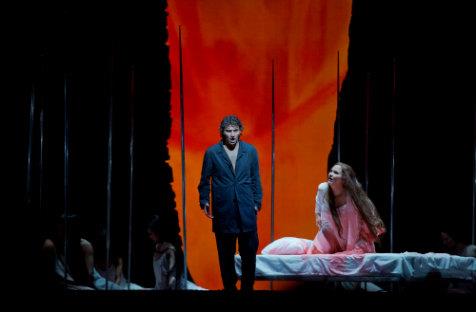The resources of the Metropolitan Opera have enabled audiences around the world to see productions that are too expensive for local opera companies to stage in their intended form. Wagner’s Parsifal is a prime example, as it requires a cast of first-rate Wagnerian singer-actors, an excellent chorus, a full, lush orchestral sound and highly imaginative staging. The Met’s latest incarnation of Parsifal fulfils all of these requirements superbly well.
It could be argued that any translation of Wagner’s opera into a modern context is unnecessary. The universal themes of great works of art, such as this operatic masterpiece, can be communicated powerfully without the use of any devices such as clothing to emphasise their relevance to contemporary society. This production of Parsifal begins with the numerous, male members of the Met chorus lining up to discard ties, suit jackets, watches and shoes, laying them in neat piles in front of them. It is an effective ritualistic gesture, reflecting the devotional society to which they belong in the sanctuary of the Holy Grail; they have put aside worldly things. The white shirt becomes a religious vestment, which by Act 3 is soiled and ragged. This reflects the sorry plight of the Grail knights, brought about by the sins of Amfortas. Parsifal’s restoration of the spear and his healing of Amfortas are accompanied by him donning a pristine white shirt and being accepted into the order. Apart from that and the use of simple office chairs, director François Girard has relied on more timeless devices.
He and designer Michael Levine have placed the action for Acts 1 and 3 on brown, cracked earth, which sometimes sits uncomfortably with the libretto. The back projections for these acts, however, are generally highly effective, incorporating stunning celestial images that do in fact match the text. The mysteries of space and time are evoked as a deeply moving spiritual dimension. For Act 2, set in the magical domain of the vengeful sorcerer Klingsor, the stage is transformed into a huge pool of blood, the costumes and characters becoming more and more bloodied as the act progresses. Giraud uses the flower maidens to create a series of striking tableaux throughout this act. Indeed, the chorus is highly choreographed throughout the opera; there is not one static moment.
The Met orchestra under Daniele Gatti is superb and the singing of all the major characters for this production is outstanding. The libretto calls for a handsome hero and Jonas Kauffman is just that. His voice is also suitably heroic with Wagnerian power and vitality as well as beauty. Although he appeared a little uncomfortable early in the opera as the naïve and playful fool, his gradual transformation when resisting the advances of Kundry, and later as an enlightened, compassionate soul, were much more convincing. His Act 2 duet with a wonderfully impassioned Katarina Dalayman as Kundry was excellent. René Pape’s Gurnemanz was, for me, the vocal highlight of the opera – a real tour de force.
The imagination, ingenuity and musical power of this production of Parsifal make this a tremendously rewarding opera experience. These HD broadcasts do constrain you to see only what the camera editor selects and, in this case I’m afraid, you have to put up with a camera used for the long shots that is irritatingly out of focus. The sound quality of the films is also only as good as the speaker system of your local cinema. Fortunately, most have invested in good systems, but, as the Met presenters always point out, there is nothing quite like the unfiltered experience of truly live opera.
Rating: 4 stars out of 5
Parsifal
By Richard Wagner
Conductor: Daniele Gatti
Director: François Girard
Set Designer: Michael Levine
Cast includes Jonas Kaufmann, Katarina Dalayman, Peter Mattei, Evgeny Nikitin,
René Pape and Daniele Gatti
The Metropolitan Opera Live in HD
Screened 13 – 14 April in selected cinemas
Actors:
Director:
Format:
Country:
Release:





